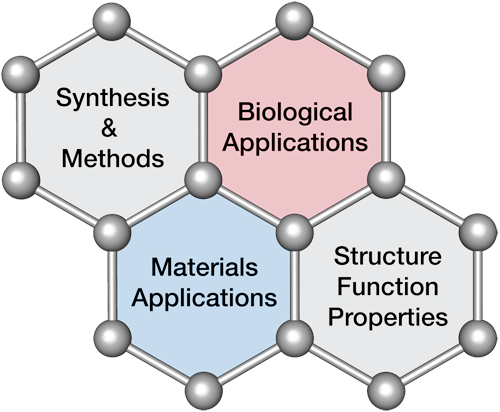

Research Overview
Modern organic synthesis allows researchers the power to precisely design, prepare, and vary molecular structures. In our research program, we combine new and established synthetic methods to prepare molecules designed to address two important and interrelated goals. First, we are interested in developing new molecules and approaches for probing, manipulating, and imaging biological systems. Elucidating the complexities of life requires tools and experimental techniques that operate on comparable time and space scales. The development of new tools for spatial and temporal control of biological systems will provide insight into fundamental biological processes. Our second goal is to develop new molecules that can modulate nucleic acid and protein structure and function. Because the structure of biomolecules is essential to their function, this goal has the potential to provide insight into fundamental biological processes in addition to the discovery of both novel therapeutics and new therapeutic targets.
Specific Project Areas:
1. Chemical Tools for Probing, Manipulating and Imaging Biological Systems
-Spatial & temporal control of cellular events
-Methods for rapidly synthesizing new fluorophores
-New photoswitchable and photoconvertable fluorophores
-Elucidation of fundamental cellular processes
Science 2017, 358, 668.
Nature Chem. Bio. 2017, 13, 1096.
Chemical Science 2015, 6, 4508.
Angew. Chem. Int. Ed. 2015, 54, 6442.
Current Biology 2015, 10, R407.
Chemical Science 2015, 6, 5128.
Nature Communications 2014, 5, 5475.
J. Am. Chem. Soc. 2013, 135, 9213.
2. Molecular Approaches for Selective Modulation of RNA/DNA Structure & Function
-Design of nucleic acid junction targeting molecules
-Small molecule targeting of specific RNA structures
-Synthesis of natural product inspired molecules for targeting nucleic acid structures
-Chemical biology, biochemical, biophysical, and structural studies
Angew. Chem. Int. Ed. 2016, 55, 8258.
Chemical Science 2015, 6, 4752.
Angew. Chem. Int. Ed. 2014, 53, 13746.
J. Am. Chem. Soc. 2013, 135, 9213.
Angew. Chem. Int. Ed. 2012, 52, 415.
3. Biopolymer Molecular Recognition and Self-Assembly
-Fundamental studies of non-covalent interactions and self-assembling systems
J. Am. Chem. Soc. 2017, 139, 9427.
Nature Nanotechnology 2017, 12, 41.
J. Am. Chem. Soc. 2016, 138, 9751.
J. Am. Chem. Soc. 2016, 138, 10157.
J. Am. Chem. Soc. 2015, 137, 12422.
Chemical & Engineering News, 2015, 93(38), 7.
Angew. Chem. Int. Ed. 2015, 54, 10826.
4. Multivalent Supramolecular Systems for Diverse Applications in Imaging, Sensing, Drug Delivery and Light Harvesting
J. Am. Chem. Soc. 2017, 139, 14733.
J. Am. Chem. Soc. 2016, 138, 10157.